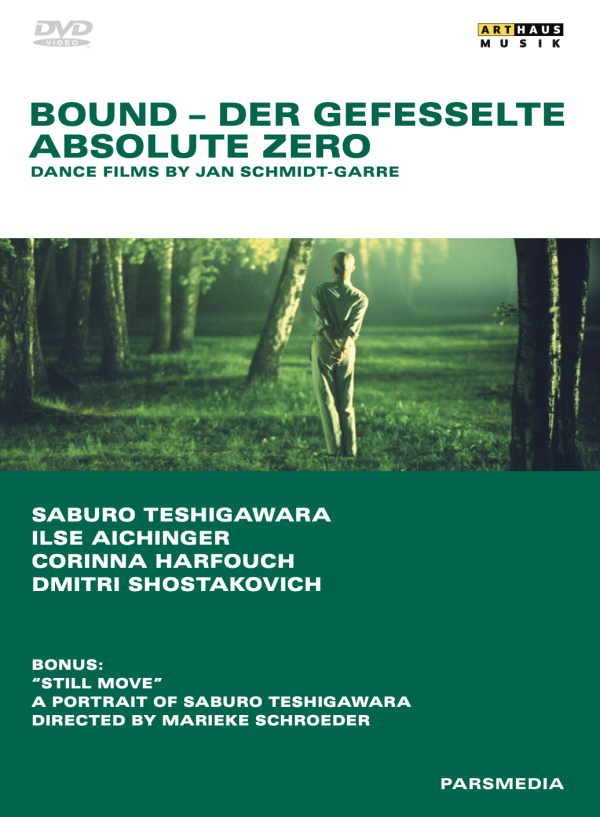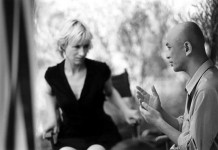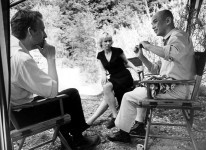Still Move
Facts
Dance Documentary, 45 min, 2003Directed by Marieke Schroeder
Still move is a portrait of the Japanese choreographer Saburo Teshigawara, covering his famous piece "Absolute Zero" as well as his new work for the camera in the feature film "Bound". The creation of a choreography is closely watched and talked about from the first day of rehearsal to the last day of principal photography. Teshigawara’s philosophy of dance and life from Zen to classical ballet is discussed in many interviews and debates. Still Move is an insight in the philosophy of one of the most important choreographers of our time.
Featuring Corinna Harfouch and Akram Khan
Cinematography: Thomas Bresinsky, Pascal Hoffmann, Martin Farkas
Editor: Gaby Kull-Neujahr
Co-produced by ZDF/3sat and SF
Supported by Media+
Releases
On DVD with Arthaus Musik:
Texts
"Bound" and "Absolute Zero" – Interview
Jan Schmidt-Garre in conversation with Dinko Skapurovic, September 2005
How did the idea come about to turn Ilse Aichinger’s short story, “Bound”, written in the 1950s, into a dance performance?
I read it in a philosophy course in college and I was fascinated by it – on the one hand because of its perfect prose and on the other because of its subject matter: the dialectic between freedom and form. And I had this insidious reflex that directors probably always have when they discover something they like: I want to do something with that! After the project had been dormant for a while, it suddenly became clear to me that dance could be the right medium: dance as the transliteration of bonds.
At what stage of the project did the Japanese choreographer and dancer Saburo Teshigawara become involved?
I had looked for the right choreographer for years before I saw Teshigawara’s “Absolute Zero”. I was totally fascinated by it, especially the middle part, which I was fortunate to be able to videotape later. I thought to myself: that’s the choreographer I want for “Bound” and I want him to dance it himself – Teshigawara.
Your video of the middle part of “Absolute Zero” really does show how fascinating Teshigawara is as a dancer...
In “Absolute Zero“, there are moments that are impossible for the camera to capture. At one point he stands there with his back to the audience for two minutes before he very slowly turns around. That was so intense on the stage. The 1,000 people in the theater were totally spellbound by the sight of his motionless back. Tremendous. On the other hand there are these incredibly rapid, snakelike movements that I tried to film in a very rigid style. The camera does not participate in what is happening, with pans or tracking shots, but is like a window behind which something very exciting is happening. Sometimes it’s visible, sometimes it’s not.
What happened to the concept of “Bound” after Teshigawara joined the project?
It was his suggestion that the role of the circus director’s wife be cast with a non-dancer. I thought this character should be embodied by a dancer who dances this “not–able-to-dance”. But Teshigawara had plenty of experience with non-dancers and he knew he could teach them a kind of dance in a very short time by means of showing them how to control their breathing. That’s perceptible in the rehearsals we shot for Marieke Schroeder’s documentary “Still Move”. I suggested Corinna Harfouch and they worked very well together.
Let’s talk about the formal aspects and the aesthetic considerations of “Bound” – what was important to you?
One important question was that of the locations. The natural settings, as Ilse Aichinger describes them in her story – a meadow, a forest, a river – are metaphors, actually spiritual spaces. It’s not nature that you can smell and touch. But film is a primitive medium: if you set up a camera in a forest, the result, at least at first, is one-to-one a forest. The artificiality Aichinger had in mind and what I especially needed in connection with dance would not work there. So I originally thought we’d have to use interiors and I wanted to do it in a big castle where there were all different kinds of rooms: a ballroom, a smaller room for the intimate scenes, a staircase perhaps for the meadow. But then that seemed cowardly and far-fetched and I thought: maybe we could find locations in nature that with the help of lighting and staging could have some of that artificiality. So I started scouting for locations that had a certain purity, a meadow that was a perfect meadow, no trees or chimneys in the background. Finding one was very difficult. The next step was to light it as if it were a stage set. That was only possible with an extreme lighting concept, in which we pitted yellow artificial light against bluish sunlight, that isolated the characters, that set them apart and gave them a golden aura. So nature suddenly looked like a painted ply board backdrop. It worked very well on the meadow and the forest looks much more like a stage set or a fairy tale forest than a real one.
What aspects were important to you as regards the content of the story?
The problem of artistic form. The man’s bonds help him discover a beauty in motion that was not possible otherwise – limitations are what create the space for art. That goes for simple forms like strophic songs and especially for highly developed ones like classical dance, with endless rules and thousands of limitations. But within these limitations, the freest and greatest art can be created. Ilse Aichinger shows this very well with the character of the bound man, especially by connecting him to the other pole of creation, the wild animal, in this case the wolf. With its animalistic innocence, it is not impaired by individuality and all of its movements are sleek and beautiful. That’s why the bound man and the wolf understand each other perfectly, because they both – in different ways – transcend normal men. That’s why their dance works. And that’s why the bound man, even though he doesn’t seem to have a chance against the wolf – first of all because he’s a man, and then because of his bonds – is able to subjugate him. So you could say that artists, for that brief moments of creation, overcome the banality of their day-to-day existence and touch the locked gate to paradise. And that takes us to the other great piece written on this subject, Kleist’s essay on the Marionette Theatre.



